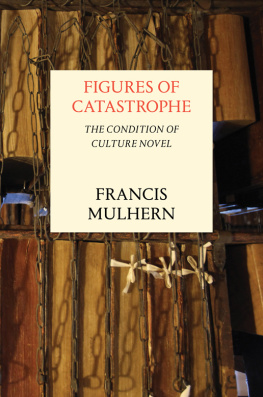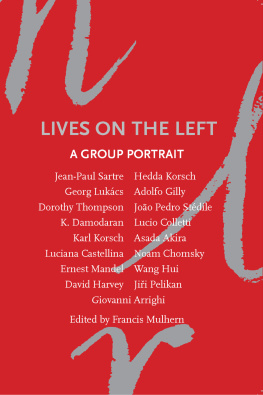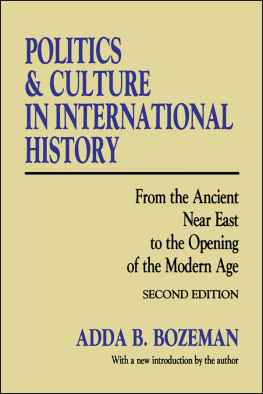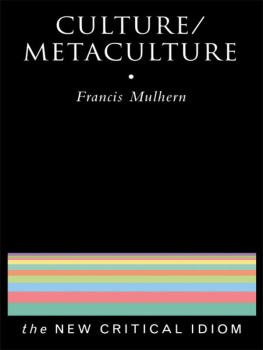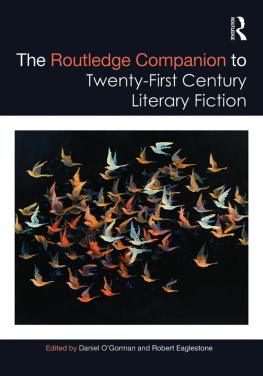Mulhern, Francis.
/ Francis Mulhern.
Includes bibliographical references and index.
ISBN 978-1-78478-191-0 (hardback)
1. English fiction20th centuryHistory and criticism. 2. Literature and societyEnglandHistory20th century. 3. Labor movement in literature. 4. Working class in literature. I. Title.
This book had its effective beginning in an invitation to teach for a semester in the English Department at Johns Hopkins University. But its basic conception lies further back in time. Nearly forty years ago, I wrote The Moment of Scrutiny, a book that attempted to reconstruct the history of a highly charged passage in twentieth-century cultural criticism. Out of a sentence or two in its closing pages, years later, came a second book, Culture/Metaculture, a general critique of cultural criticism and its successor formation, cultural studies. Here, now, is another marsupial birth, this one germinated in the course of a critical exchange over Metaculture in which it came to me that the literary self-representations of culture a few novels immediately suggested themselves told a darker story than anything to be found in the record of cultural criticism proper, with its defining commitments to the great powers of form and idea, or what Matthew Arnold termed sweetness and light. Thus, after further years of work, including some big surprises, the initial opportunity afforded by Hopkins has led to Figures of Catastrophe, the third part of an unplanned, informal trio offering elements of a critical history of metaculture, the discourse in which the principle of culture speaks of itself and its general conditions of existence.
Fundamental matters of theory are involved here. Nevertheless, as one friendly reader has pointed out, this is a book that does without any more or less elaborate preamble concerning theory or method. He was not suggesting that there was an omission to be made good. But a few opening indications may not go amiss. This is an essay in Marxist formalism, the noun emphasizing the making of meaning as the proper object of literary study, the modifier marking off an orientation in historical understanding and a political commitment. In a way it is full of theory, years worth of it, as presupposition or implication or simple trace of reading, and from time to time as explicit citation. But my leading purpose here is not theoretical, even if an attempt to clarify and illustrate the scope and potential of a certain understanding of genre gives the work its conceptual accent. Its main mode is literary-historical, and my hope is that the Introduction provides as much preliminary discussion as will be needed.
This is a book about novels, and specifically the genre I call the condition of culture novel or rather, a group of novels I take to instantiate what I take to be a genre. My pedantic phrasing has a point. Neither the group as the novels now are nor the ascription was pre-given. They and it emerged in a dialectic that remains unfinished, leaving all conclusions provisional. The group is largely literary in character, belonging to the overlapping canons of academia and polite journalism, and I cannot say what there may be to find in a developed international comparison, not to speak of the great expanses of unashamed genre writing, or the marginal, oppositional initiatives of avant-gardes: only that there will certainly be something, and that it seems unlikely that my general characterizations will emerge unqualified from new encounters in those cultural registers. Others will report in due time.
Authors acknowledgements, especially those of academic provenance, seem more and more drawn to self-promoting or maudlin excursions in life-writing. I hope to avoid these embarrassments while not scanting my debts. Looking back on the semester at Hopkins and the English graduate seminar in which this book originated, I am reminded of what I owe to Amanda Anderson, Simon During, Frances Ferguson, Christiane Gannon, Susie Hermann, Rob Higney, Kevin Lenfest, Beth Steedley and Karen Tiefenwerth. My thanks to them all.
For a timely provocation I owe a particular debt to Stefan Collini.
Perry Anderson, Franco Moretti, Peter Osborne and Susan Watkins all made valuable criticisms and suggestions, to which I hope I have done some justice.
Rachel Maliks critical advice and support were crucial throughout.
The aim of this short study is to uncover the topics and forms of an unnoticed genre in English writing since the 1890s: the condition of culture novel. This wording is ungainly, it is true. My plea of justification is that, in its emphatic recall of Thomas Carlyles famous phrase, the condition of England,to uphold a distinction between this genre, with its constitutive emphasis on culture, and the broader, and much older, tradition of social realism of which it is, perhaps, no more than a subset. But it does, nevertheless, dictate a principle of selection in the miscellaneous generality of novels about culture. Novels such as George Gissings New Grub Street (1891), Somerset Maughams Cakes and Ale (1930), Evelyn Waughs Scoop (1938) and Murray Sayles A Crooked Sixpence (1960) are in their different ways notable critical treatments of literature and journalism in their time, but they are all more or less specialized in focus, not synoptic. The same can be said about Kingsley Amiss Lucky Jim (1954), Angus Wilsons Anglo-Saxon Attitudes (1956) or Malcolm Bradburys The History Man (1975) as novels with a focus in the university. The distinctive character of the condition of culture novel is that it is both synoptic and specific, foregrounding the cultural dimension of the social whole, undertaking a synoptic narrative evaluation of the social relations of culture.
My detailed discussions range across more than a dozen novels, and at least as many more make brief appearances. It may make for an easier passage through these introductory remarks if the primary texts are identified now, in order of treatment and grouped according to the four main chapters of the book:
Thomas Hardy, Jude the Obscure, 1896
E.M. Forster, Howards End, 1910
Virginia Woolf, Orlando, 1928
, Between the Acts, 1941
Evelyn Waugh, Brideshead Revisited, 1945
Elizabeth Bowen, The Heat of the Day, 1948
Stan Barstow, A Kind of Loving, 1960

